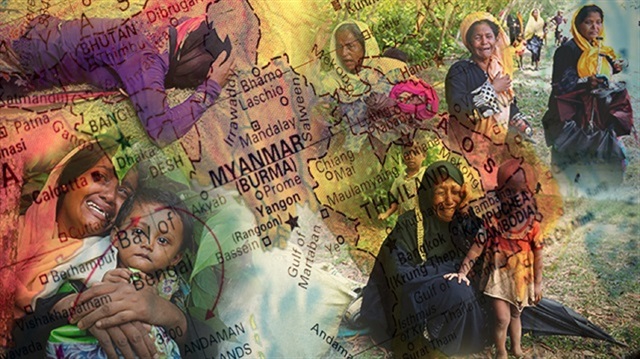

Rohingya Muslims in Rakhine face the oppressive and cruel policies of the Myanmar government.
Rohingya Muslims have been under the oppression of the Myanmar government since 1948 when the country declared its independence
Myanmar, officially the Republic of the Union of Myanmar, also known as Burma is located in Southeast Asia, along the Andaman Sea and the Bay of Bengal. Myanmar is divided into seven states, Rakhine being one of them, located in the northwestern coast of the country.
Myanmar declared its independence in 1948, which does not mean there is a civilian administration. Junta members and pro-Buddhist administrators have since then governed the country.
Root of the problem: ‘Stateless’ decision in 1982!
The primary reason of the massacres against Rohingya Muslims is that the Myanmar government does not recognize them. The government declared this situation official with the 1982 Nationality Law, and has continued with it since the country’s foundation.
While the law enacted in 1982 recognizes all ethnic groups as citizens, the Rohingya people are not included in this; they’re not recognized as the citizens of Myanmar, and officially declared as “stateless” by the law.
The Muslim population living in Rakhine used to be 3.5 million. However, this number hass decreased to approximately one million, due to the Myanmar government’s offensives and massacres.
The Myanmar government denies citizenship to the Rohingya Muslims, claiming that they are from Bangladesh, and were brought to Rakhine during the British colonization period in the 1800s. According to official figures, 89 percent of the country consists of Buddhists. However, Muslims constitute around 20 percent of the population of Myanmar, according to the reports of international organizations.
It is estimated that the population of Rohingya Muslims living outside Myanmar is more than one million. Taking refuge mostly in Bangladesh and India, the Rohingya refugees living in those locations are threatened with extradition.

Behind the curtains
The incidents which are used as a pretext for the massacre of Rohingya Muslims, who have had an “identity” problem because of the Myanmar government, broke out in 2012.
To summarize, three Buddhist priests raped and slaughtered a 26-year-old woman from Myanmar in May, 2012. The priests escaped and left the body of the young woman near a Muslim village. After the body was found, the Buddhist priests and the Myanmar Government officials framed the Muslims for the woman’s tragic demise. Three Muslim young men, who had nothing to do with the matter, were arrested after the Buddhists defamed them as the perpetrators of the crime. One of the arrestees was beaten to death. The other two were sentenced with the death penalty by the Myanmar courts. The Myanmar government, thus, took the first concrete steps towards a massacre against Muslims, in front of the entire world.
Following this incident, an anti-Rohingya propaganda started to spread in Myanmar. The government once again ostracized the Muslims, claiming that Rakhine is not a state of Myanmar, and declared the Rohingyas as illegal immigrants from Bangladesh.
What do the Rohingyas want?
Rohingya Muslims, who are ostracized and ignored by the Myanmar government, demand:
1-
To be granted citizenship
2-
The end of the attacks on their lands
3-
That their rights are recognized
What does “Rohingya” mean?
The term Rohingya means “the soul achieving salvation.” Rohingya Muslims used to use this expression when they were burying bodies. It has become widespread over time, and is still being used by the Rohingya Muslims.
#Myanmar
#Rohingya
#Rakhine
#Burma


